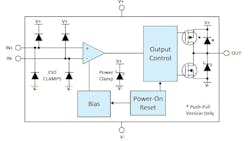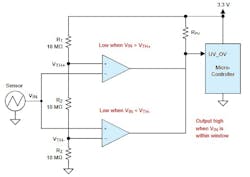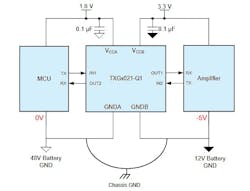Single-Function Analog ICs Resolve Big Automotive-Circuit Issues
What you’ll learn:
- The ongoing need for intra-circuit interface and limited-functions ICs.
- How small analog ICs can enable critical transitions and meet specialty roles.
In a hard-to-articulate way, it’s somewhat comforting to know that even in our world of highly integrated, multifunction analog and digital ICs, there’s still a need for small-scale analog ICs that focus on a single function, or enable subcircuit A to work with subcircuit B.
In many ways, these basic blocks are the modern equivalent (dare I say “analog”?) to the legendary single-function digital “glue logic” interface ICs of the 1970s. They enabled small-scale integration (SSI), medium-scale integration (MSI), and even large-scale (LSI) devices to work with each other.
Today’s parallels to these roles can be seen in two new product families from Texas Instruments, both targeted toward automotive designs and therefore qualified to AEC-Q100 (Grade 1, –40 to 125°C):
High-Speed 2.7- to 40-V Comparators
The TLV183x-Q1 and TLV184x-Q1 devices are high-speed comparators—a fundamental system function—that operate at voltages between 2.7 and 40 V. The TLV183x-Q1 devices (Fig. 1) have a push-pull output stage, intended for applications where symmetry between rising and falling output responses is desired. In contrast, the otherwise similar TLV184x-Q1 comparators have an open-drain output stage, making them appropriate for level transition (the “x” suffix refers to package style, not functionality).
These comparators offer rail-to-rail inputs, and their 65-ns propagation delay makes them a good fit for high-speed current-sensing and voltage-protection applications. Supply current is just 75 μA, while input offset voltage—an important factor for maintaining functional accuracy—is just 500 μV.
All devices in these families incorporate a Power-On Reset (POR) feature to ensure that the output is in a known state during the power-up phase until the minimum supply voltage has been reached. Once this voltage is reached, the output responds to the inputs, thus preventing false outputs during system power-up and power-down transitions.
Any basic comparator configuration can produce a noisy and misleading "chatter" output if the applied differential input voltage is near the comparator's offset voltage. It usually occurs when the input signal is moving very slowly across the switching threshold of the comparator.
This well-known problem can be minimized by incorporating external hysteresis around the comparator by using a few resistors. The datasheet for these devices goes through the needed calculations, showing some possible hysteresis configuration and how to size the resistors to provide the desired amount.
The datasheet also shows some typical applications, such as a window comparator that’s commonly used to detect undervoltage and overvoltage conditions (Fig. 2). Note that window comparators require open drain outputs (TLV184x-Q1) if the outputs are directly connected together with a single output indicating both overvoltage and undervoltage conditions.
The TLV183x-Q1 and TLV184x-Q1 come in a range of five- and eight-pin packages, each measuring just a few millimeters on each side. If you assume that a relatively simple function such as a comparator also has a short, simple datasheet, that’s not the case. Even this basic function has its subtleties, timing considerations, thermal-drift issues, and more; the datasheet for these comparators runs 38 pages.
Voltage- and Ground-Level Translators
The TXG102x-Q1 devices are two-bit, fixed-direction, non-galvanic-based voltage- and ground-level translators that can support both logic-level shifting between 1.71 to 5.5 V and ground-level shifting up to ±10 V. The ICs are offered in two variations (not counting packaging options): the TXG1020-Q1 with two forward paths and the TXG1021-Q1 with one forward and one reverse path (Fig. 3).
Compared to traditional level shifters, the TXG102x-Q1 family can solve the challenges of voltage translation across different ground levels (remember, there’s no such thing as a perfect ground, only degrees of imperfection). It’s an insidious problem that can frustrate designers as it often induces hard-to-capture intermittent problems as well as static ones.
For example, the TXG102x-Q1 enables communication between devices or systems operating at different interface and ground voltages, in cases where two systems that translate from 1.8 to 3.3 V also experience a ground shift of 5 V (Fig. 4). This ground shift occurs due to the parasitic resistance of the cable used to connect the 48-V battery ground and 12-V battery ground to the chassis of the car.
These eight-pin devices have some non-obvious specifications, in addition to the more obvious ones. They include:
- AC-noise rejection of 20 V p-p up to 45 MHz.
- Common-mode transient immunity (CMTI) of 1 kV/μs.
- Low propagation delay (<5 ns) and low channel-to-channel skew (<0.20 ns).
- Speeds greater than 250 Mb/s.
- Supports VCC disconnect feature (where inputs and outputs are forced into high-impedance mode).
- Schmitt-trigger inputs allow for slow and noisy signals.
- Inputs with integrated static pull-down resistors prevent channels from “floating.”
The fully configurable dual-rail design allows each port to operate from 1.71 to 5.5 V, while power consumption is just 0.8 mA per channel at 1 Mb/s (1.8 V). Details are in the 30-page datasheet, which includes switching characteristics under different voltages, various waveforms, application guidelines, and much more.
References
Texas Instruments, Application Note SBOA219, "Comparator with and without hysteresis circuit"
Texas Instruments, Application Note SNOA997, "Inverting comparator with hysteresis circuit"
Texas Instruments, Application Note SBOA313 "Non-Inverting Comparator With Hysteresis Circuit"
About the Author

Bill Schweber
Contributing Editor
Bill Schweber is an electronics engineer who has written three textbooks on electronic communications systems, as well as hundreds of technical articles, opinion columns, and product features. In past roles, he worked as a technical website manager for multiple topic-specific sites for EE Times, as well as both the Executive Editor and Analog Editor at EDN.
At Analog Devices Inc., Bill was in marketing communications (public relations). As a result, he has been on both sides of the technical PR function, presenting company products, stories, and messages to the media and also as the recipient of these.
Prior to the MarCom role at Analog, Bill was associate editor of their respected technical journal and worked in their product marketing and applications engineering groups. Before those roles, he was at Instron Corp., doing hands-on analog- and power-circuit design and systems integration for materials-testing machine controls.
Bill has an MSEE (Univ. of Mass) and BSEE (Columbia Univ.), is a Registered Professional Engineer, and holds an Advanced Class amateur radio license. He has also planned, written, and presented online courses on a variety of engineering topics, including MOSFET basics, ADC selection, and driving LEDs.




